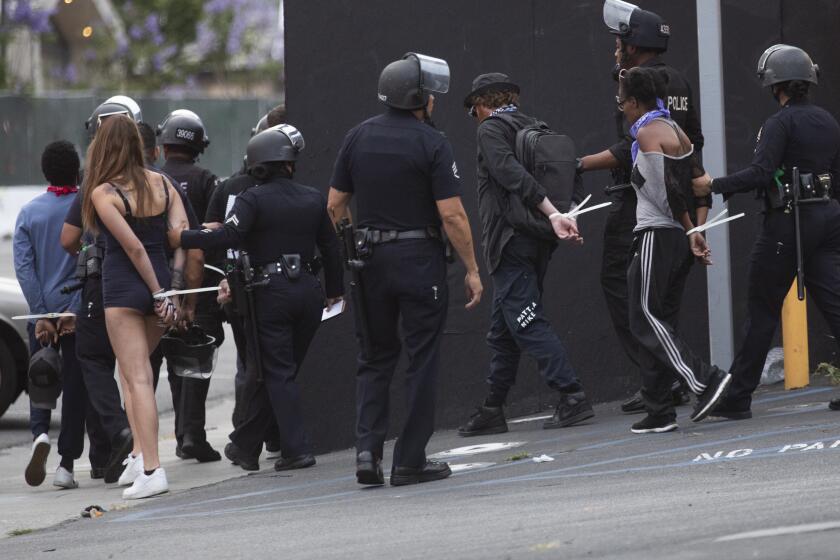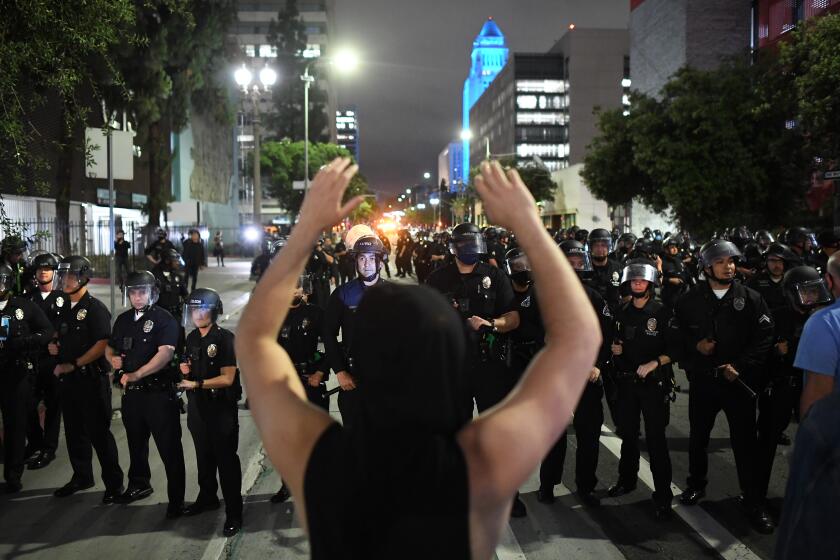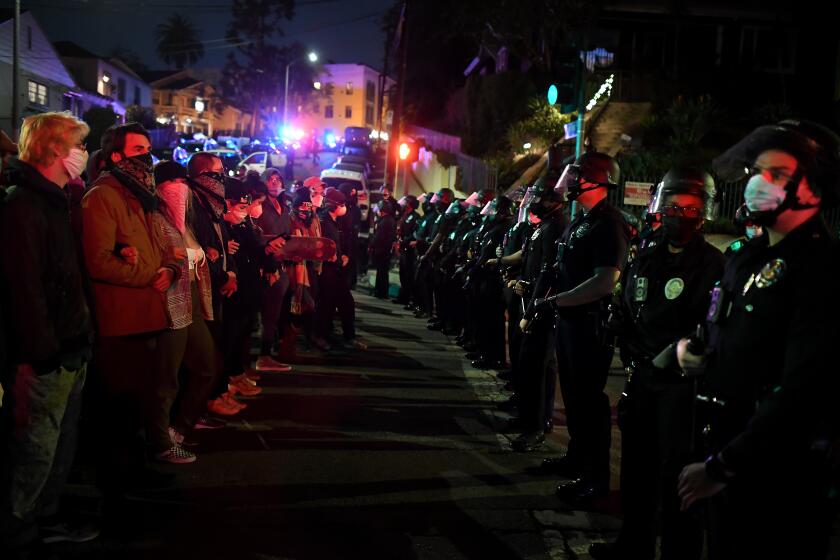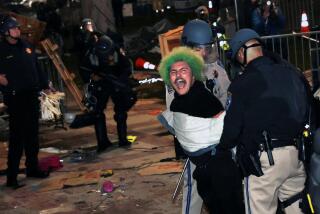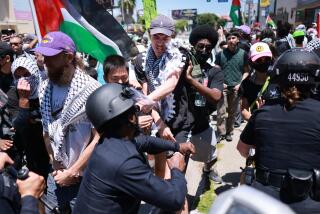‘It stood out to me as egregious’: Protesters, others allege LAPD violence at Echo Park sweep
LAPD officers were again captured on video appearing to violate department policies for the use of projectile weapons, which bar them from shooting people who don’t represent a physical threat.
- Share via
One protester said he suffered a massive welt and deep purple bruising on his thigh after being shot with a projectile by a Los Angeles police officer at close range in Echo Park last week. Another protester on the same skirmish line said an officer broke his arm with an aggressive baton strike.
The next night, in the same neighborhood, a news photographer suffered a large circular welt on his abdomen and another on his arm after, he said, an officer shot him with a projectile at “point blank” range. A local resident caught up in the commotion said she suffered a concussion after twice being thrown to the ground by officers in the alleyway next to her home.
Another protester and her partner said they each were shot with projectiles at close range; he was bloodied and bruised on the arm and she was left with a welt across her ribcage. A third protester captured startling video of an officer repeatedly firing projectiles into their small group — at times with the bright green barrel of his “less lethal” weapon just feet from protesters’ faces.
“Leave the area!” the officer shouted.
“What the f— is wrong with you?” a protester screamed back.
Despite months of criticism and a growing number of lawsuits over the LAPD’s use of such force during last summer’s George Floyd protests and last fall’s unruly Lakers and Dodgers championship celebrations — which left protesters and revelers bloodied, with ruptured testicles and an “exploded” eye — officers are again being criticized for their use of those weapons last week, this time as they responded to protests over the removal of a homeless encampment around Echo Park Lake.
Officers were again captured on video using the weapons in ways that appeared to violate the department’s policies, which bar officers from shooting people who don’t represent a physical threat and from shooting into crowds, shooting people at close range and shooting people merely for ignoring verbal commands.
LAPD used violence to quell protests over police brutality, using batons and ‘less lethal’ bullets in ways that probably violated protocols.
The department has largely defended its actions, alleging that officers had sought to facilitate the protests until they became unruly and decisions were made to issue dispersal orders and arrest those who didn’t comply. It said officers fired just a couple of projectile rounds the first night and 10 the second, including three 37-millimeter hard foam rounds, one 40-millimeter hard foam round and six beanbag rounds, all “in response to projectiles thrown at officers.”
LAPD Chief Michel Moore also defended the department’s response, saying the dispersal orders were issued only after officers faced violence and, on the second night, the use of strobe lights to blind them. He said such actions by protesters should be condemned, including by elected officials.
Moore also said the LAPD is committed to investigating any use of force that caused serious injuries or sparked a complaint, and will hold officers accountable if they broke policy. He said 11 complaints were already under review, including two pertaining to the detention of reporters and one pertaining to protester Isaac Scher’s allegation that an officer broke his arm.
Isaac Scher says his arm was broken when an LAPD officer swung a baton at him on an Echo Park skirmish line Wednesday night.
Moore said the department has learned lessons from last summer, put officers through additional training, and saw improvements last week in how it handled the protests and processed those arrested. He noted that officers used their projectile weapons far more sparingly than they did last summer.
Nonetheless, protesters, members of the media and other observers blasted the department’s response as heavy-handed.
They say the latest injuries are further evidence of a police force that has either completely lost control of its officers in crowd control settings, or — worse — justified the misbehavior by repeatedly failing to sufficiently train and discipline officers who run afoul of the rules, despite public admonishments and multimillion dollar excessive force settlements.
The LAPD mishandled the unrest that erupted after the death of George Floyd, according to a new report commissioned by the City Council.
In interviews with The Times in the last week, a half-dozen wounded Echo Park protesters, journalists and bystanders acknowledged that protesters were giving police a hard time. Some objects like water bottles were thrown at officers, and a few suffered minor injuries. But those who were shot or otherwise injured by officers strenuously denied that the officers — clad in riot gear — were in any real physical danger when they began lashing out.
“That’s why I stayed — because it stood out to me as egregious. It stood out to me as excessive force,” said Christian Monterrosa, a 28-year-old Los Feliz-based photographer who has LAPD-issued press credentials and was shot in the abdomen and arm at close range Thursday night. “I could chalk it up to inexperience, but ... at this point every LAPD officer has been on the front line of a protest.”
Monterrosa and several others said they were shot as they backed away from a line of officers advancing toward them in a parking lot between Sunset Boulevard and Echo Park Lake. The small group had gathered to observe the LAPD as they surrounded a much larger group of protesters on nearby Lemoyne Street.
Alex Kanegawa, one of the protesters in the smaller group, said the advancing officers started brandishing their guns aggressively and sticking them in people’s faces, infuriating the protesters and slowing their retreat.
The LAPD is being sued for violence against protesters — again. The department committed to policy changes after incidents in 2000 and 2007.
After one officer stuck the green barrel of his weapon in the face of Kanegawa’s partner, Nara Kim, 27, he moved to her side to pull her away from the weapon, he said. That’s when he was shot in the back, he said, with the projectile crushing a plastic first-aid kit in his backpack. He also was shot in the arm, which left a major welt, he said.
Kim said she was shot on the left side of her abdomen, also leaving a welt. She said she didn’t see any projectiles being thrown at the officers and didn’t think the group was a threat, even if they were screaming at officers to lower their weapons.
“It just felt like the violence that was there was so unnecessary,” she said.
Di Barbadillo, 35, a law school employee and sometimes legal observer at protests who recorded the encounter, said she is familiar with the LAPD’s policies for “less lethal” munitions — and they weren’t followed Thursday night.
Barbadillo said the smaller group was on a sidewalk at some distance from the area that police had cordoned off. It was questionable whether the dispersal order even applied to them, she said. And rather than walk up to the smaller group and provide precise instructions about where they wanted them to go, the officers suddenly rushed forward screaming.
“They led with their weapons,” she said.
After nearly 100 people chose to either strike or abandon their tents and accept shelter in downtown hotels, a few dozen homeless campers remained in Echo Park, vowing to resist a massive city effort expected as soon as Thursday to push them out.
Becca Standt, 21, said she wasn’t even protesting when she alleges she was assaulted by police nearby.
Standt’s bedroom window looks out on an alleyway between Lemoyne and Logan streets. She said she knew there were protests happening because police had blocked her from driving out of the area to go to work, but didn’t know how big the protests were. She said she walked down her alleyway to see if she could make out what was happening on Lemoyne.
Suddenly, she said, a line of officers charged at her and a handful of other people in the alleyway. One officer shoved her violently to the ground, she said. As she pulled herself back to her feet, she was shoved by an officer a second time, she said, this time striking her head on the pavement.
“I started vomiting and was so dizzy that I couldn’t get up,” she said. At a local emergency room, Standt was diagnosed with a concussion, according to hospital discharge records reviewed by The Times. It was a clear case of police brutality, she said.
“I was a bystander watching a protest from at least 40 yards away from where the main protest was. I was really just standing there watching,” she said.
Protesters were also injured closer to Echo Park Lake the night before, including Scher, who said his arm was broken, and Ethan Bochicchio, who said he was shot with a projectile in the leg.
Bochicchio, 23, said he was trying to move to the side of a woman he felt was being wrongly arrested when he was shoved to the ground by an officer and then shot at close range.
“I was on the ground when I got shot, which feels vindictive and spiteful,” Bochicchio said. “I can’t fathom why they would need to do that, other than distaste for protesters.”
More to Read
Sign up for Essential California
The most important California stories and recommendations in your inbox every morning.
You may occasionally receive promotional content from the Los Angeles Times.

